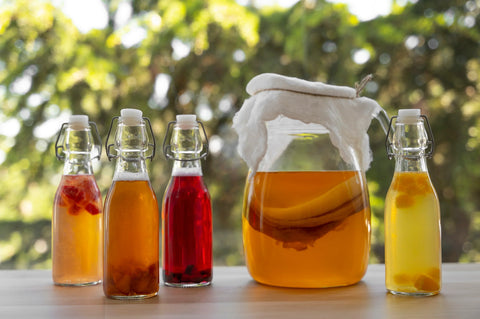Olive oil, a culinary cornerstone across the globe, has long been celebrated for its distinctive flavour and its integration into the Mediterranean diet, renowned for its health-promoting properties. While its versatility in the kitchen is undeniable, the true magic of olive oil lies in its rich composition, particularly its abundance of polyphenols. These powerful plant compounds contribute significantly to both the oil's flavour profile and its potential health benefits. This in-depth guide delves into the fascinating world of olive oil polyphenols, exploring their significance, the factors that influence their presence, and how to identify and incorporate high-polyphenol olive oils into your daily life.
Unveiling the Power of Polyphenols
Polyphenols are a vast and diverse family of naturally occurring compounds found in various plant-based foods. They act as potent antioxidants, working to neutralise harmful free radicals within the body. Free radicals are unstable molecules that can damage cells and contribute to inflammation, a key driver of many chronic diseases. Think of polyphenols as the body's defence squad, protecting cells from oxidative stress and promoting overall cellular health.
The Crucial Role of Polyphenols in Olive Oil
In olive oil, polyphenols play a multifaceted role, influencing its quality and characteristics in several key ways:
-
Health Benefits: The antioxidant properties of polyphenols are strongly linked to a range of potential health benefits. Research suggests that they may contribute to:
-
Cardiovascular Health: By helping to reduce inflammation and protect against oxidative damage to blood vessels, polyphenols in olive oil may support heart health.
-
Anti-inflammatory Effects: Polyphenols can help modulate the inflammatory response in the body, which is beneficial in managing various inflammatory conditions.
-
Neuroprotective Potential: Some studies suggest that polyphenols may have protective effects on the brain and nervous system, potentially reducing the risk of neurodegenerative diseases.
-
Sensory Characteristics: Polyphenols are not just silent protectors; they also contribute to the sensory experience of olive oil. They are responsible for the characteristic bitterness, pungency, and astringency that are often considered hallmarks of high-quality, robust olive oils. These sensations are a sign of the oil's complexity and its rich polyphenol content.
-
Oxidative Stability: Polyphenols act as natural preservatives, protecting olive oil from oxidation. Oxidation occurs when olive oil is exposed to oxygen, light, or heat, leading to rancidity and a loss of flavour and nutritional value. The presence of polyphenols helps to extend the shelf life of olive oil and maintain its quality.
The Symphony of Factors Influencing Polyphenol Content
The concentration of polyphenols in olive oil is not a fixed value; it's a dynamic characteristic influenced by a complex interplay of factors:
-
Olive Variety (Cultivar): Just as different grape varieties produce different wines, different olive varieties (cultivars) have varying genetic predispositions for polyphenol production. Some cultivars are inherently "high-polyphenol" varieties, consistently yielding oils with higher concentrations of these beneficial compounds. Prominent examples include:
-
Picual: A Spanish cultivar renowned for its high polyphenol content and robust flavour.
-
Koroneiki: A Greek cultivar also known for its high polyphenol levels and intense sensory characteristics.
-
Harvesting Time (Ripeness): The ripeness of the olives at harvest significantly impacts polyphenol levels. Earlier harvest, when the olives are still relatively green and less ripe, generally results in higher polyphenol concentrations. As olives mature, polyphenol levels tend to decline.
-
Growing Conditions (Terroir): The environment in which the olive trees are grown plays a crucial role. Factors like:
-
Climate: Temperature, rainfall, and sunlight exposure can all influence polyphenol production.
-
Soil Composition: The nutrient content and mineral composition of the soil can affect the health and polyphenol content of the olives.
-
Irrigation: Water availability and irrigation practices can also play a role.
-
Processing Methods (Extraction): The way olives are processed into oil can either preserve or degrade polyphenols. Crucial factors include:
-
Temperature Control: Minimising heat during the extraction process is essential, as heat can degrade polyphenols. Cold-pressing or cold-extraction methods are preferred.
-
Oxygen Exposure: Limiting exposure to oxygen during processing and storage is vital, as oxygen can also contribute to polyphenol degradation.
-
Filtration: Some producers choose to filter their olive oil, which can remove some sediment but may also remove some polyphenols. Unfiltered or minimally filtered oils may retain more of these beneficial compounds.
Decoding the Clues: Identifying High-Polyphenol Olive Oils
While a precise polyphenol count may not always be readily available on the label, several indicators can guide you towards selecting olive oils that are likely to be rich in these valuable compounds:
-
Extra Virgin Olive Oil (EVOO): Opt for high-quality Extra Virgin Olive Oil (EVOO). EVOO is the highest grade of olive oil, produced by cold-pressing or cold-extracting olives without the use of chemicals or excessive heat. This process helps to preserve the natural polyphenols present in the fruit.
-
Harvest Date and Freshness: Pay attention to the harvest date. Freshly pressed olive oil, ideally from the most recent harvest, will generally have higher polyphenol content. Olive oil is best consumed within 12-18 months of harvest.
-
Sensory Evaluation (Taste and Aroma): Engage your senses! High-polyphenol olive oils often exhibit distinct sensory characteristics. Look for:
-
Bitterness: A pronounced bitterness, particularly at the back of the tongue, is a positive sign.
-
Pungency: A peppery or pungent sensation that causes a slight burning sensation in the throat is another indicator.
-
Aroma: A complex aroma with notes of grass, herbs, fruit, or other fresh characteristics.
-
Cultivar Information: If the label specifies the olive variety (cultivar), choose oils made from varieties known for their high polyphenol content, such as Picual, Koroneiki, or Coratina.
-
Producer Reputation: Seek out reputable producers who prioritise quality, sustainable practices, and careful processing.
To discover a range of olive oils that embody these qualities, consider exploring options from producers who are committed to preserving the integrity and polyphenol content of their oils. You can find a curated selection of High Polyphenol Olive Oil at speciality food stores or online retailers.
Harnessing the Power: Incorporating High-Polyphenol Olive Oil into Your Diet
Integrating high-polyphenol olive oil into your daily routine is not only a delicious way to enhance your meals but also a simple way to boost your antioxidant intake. Here are some practical and flavourful suggestions:
-
Drizzling: Elevate the flavour of salads, grilled vegetables, roasted meats, or fish by drizzling a generous amount of high-polyphenol olive oil just before serving.
-
Dipping: Enjoy the pure taste of the oil by using it as a dip for crusty bread, paired with fresh herbs, spices, or a touch of balsamic vinegar.
-
Finishing: Add a swirl of high-polyphenol olive oil to soups, stews, or pasta dishes as a finishing touch, enhancing both flavour and aroma.
-
Marinades: Use the oil as a base for marinades, infusing meats, poultry, or vegetables with its complex flavour and antioxidant properties.
-
Dressings: Create vibrant and healthy salad dressings by combining high-polyphenol olive oil with vinegar, lemon juice, herbs, and spices.
A Note of Caution: Moderation is Key
While high-polyphenol olive oil offers a wealth of potential benefits, it's crucial to remember that it is still a fat. Like all fats, it is calorie-dense, so consume it in moderation as part of a balanced and healthy diet.
Conclusion: Embracing the Goodness of High-Polyphenol Olive Oil
Choosing olive oils high in polyphenols can be a beneficial addition to a healthy lifestyle. By understanding the factors that influence polyphenol content and knowing what to look for, you can make informed choices and enjoy both the flavour and potential health advantages of this versatile oil.
At Nourished Communities, we are passionate about providing our customers with the best quality products. If you have any questions or would like to learn more about our selection, please don't hesitate to contact us. We're always happy to help you find your perfect product.
References:
https://pmc.ncbi.nlm.nih.gov/articles/PMC2835915






Comments (0)
There are no comments for this article. Be the first one to leave a message!